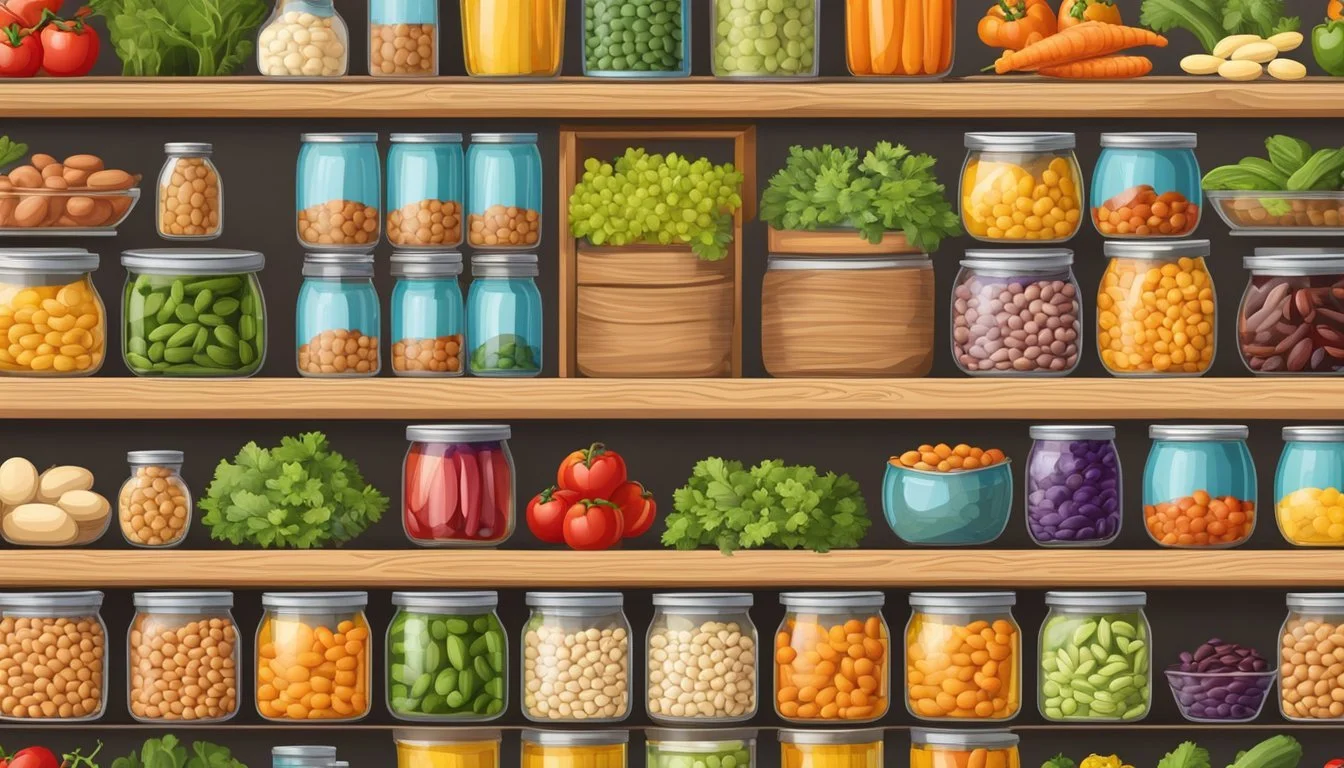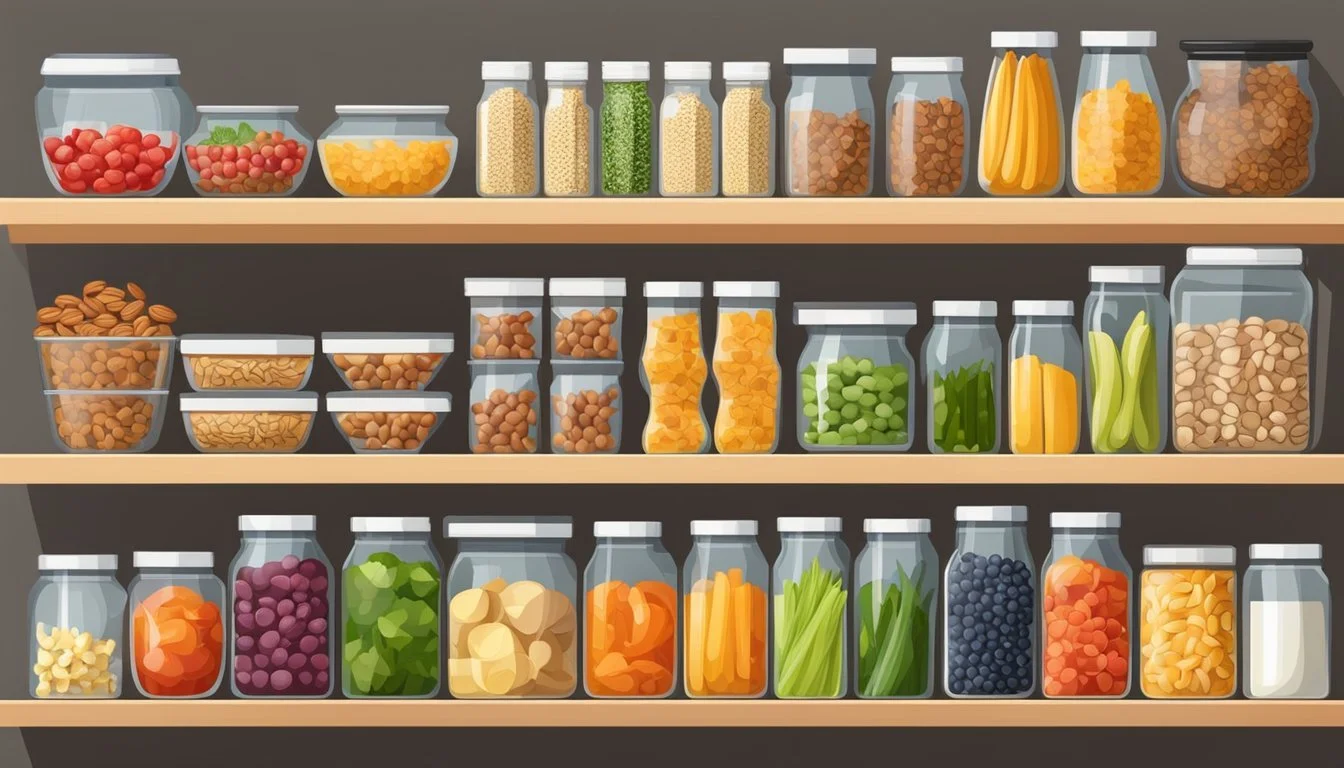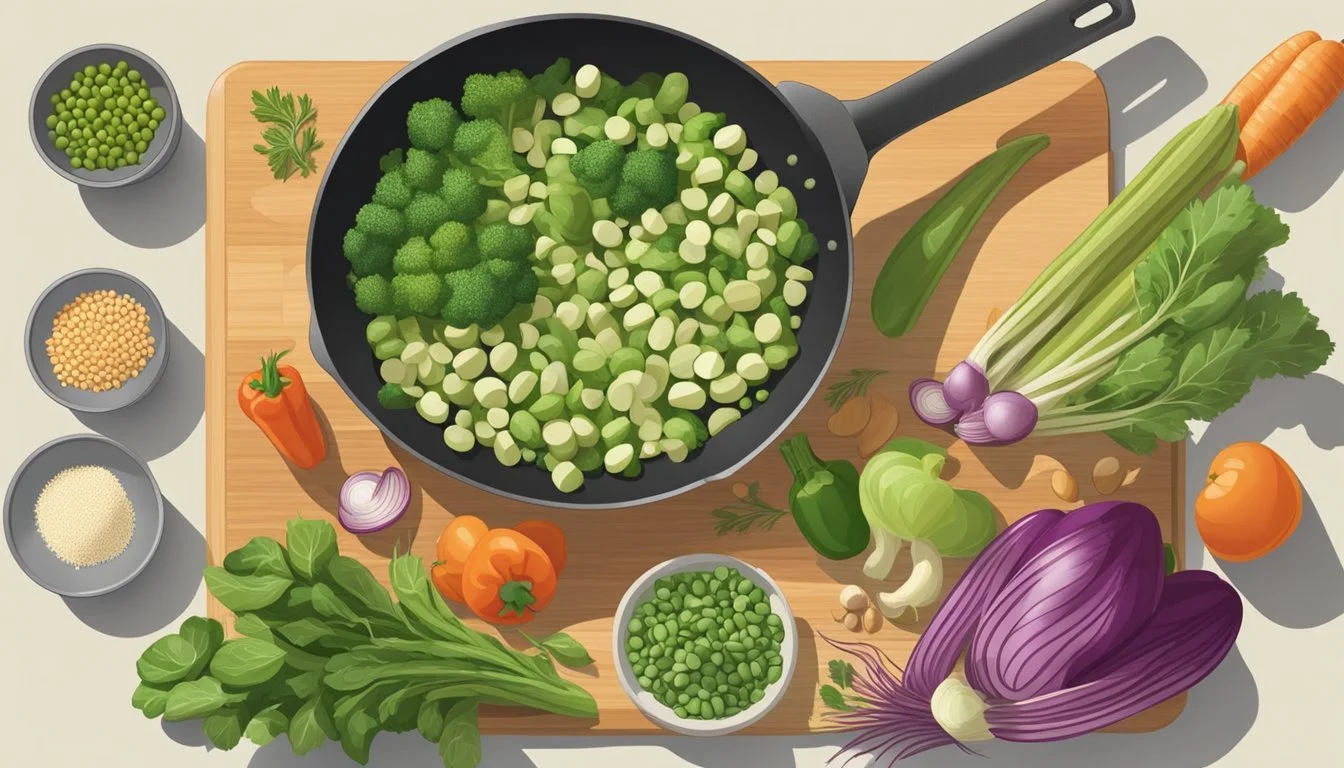Pantry-Friendly Vegetarian Meals
Quick, Nutritious Recipes for Every Day
Creating satisfying, nutritious meals exclusively from pantry staples can feel like a daunting task, but with a plethora of vegetarian options available, it's entirely possible to do so without sacrificing variety or flavor. The foundation of a well-stocked vegetarian pantry includes ingredients like pasta, lentils, canned beans, and a selection of spices and seasonings. These essentials not only provide a base for countless recipes but are also shelf-stable, making them ideal for meal planning during times when fresh produce is less accessible.
Vegetarian pantry meals cater to a range of tastes and dietary preferences, offering the flexibility to explore different cuisines and flavor profiles. From hearty three-bean curries incorporating a mix of kidney, black, and white beans, to nourishing soups and satisfying pastas, there is no shortage of dishes that can be whipped up using simple ingredients. Additionally, baking ingredients such as flour, sugars, and leavening agents ensure that homemade treats like chocolate chip cookies are never out of reach, even when one is relying heavily on pantry items.
By understanding how to combine these staples in creative ways, individuals can enjoy comforting, healthy vegetarian meals that don't require frequent trips to the grocery store. This approach to cooking not only streamlines the meal preparation process but also demonstrates that a plant-based diet can be both indulgent and convenient, relying on the resources within one's own pantry.
Essential Pantry Staples for Vegetarian Cooking
For vegetarian cooking, a well-stocked pantry is crucial for creating flavorsome and nutritious meals. Understanding what to keep on hand ensures that one can assemble a meal with ease, even on short notice.
Rice and pasta serve as the foundation for many dishes due to their versatility.
Quinoa, a complete protein, is an excellent addition for its nutritive value.
Legumes:
Canned beans and lentils are protein-packed and can be used immediately, adding substance to any meal.
Dried varieties offer a budget-friendly option with a longer cooking time.
Tomato Products:
Canned tomatoes and tomato sauce are indispensable for everything from soups to casseroles.
Broth and Spices:
Vegetable broth adds depth while being low in calories.
A selection of spices can transform the taste profile of a dish.
Nuts and Seeds:
A variety of nuts and seeds, like chia or pumpkin seeds, provide essential fats and can be sprinkled for added texture.
They should be kept refrigerated to maintain freshness.
Oats:
Oats are a staple for a fiber-rich breakfast or baking ingredient.
Maintaining these pantry staples ensures that one has the basic components for a plethora of vegetarian recipes, balancing flavor and protein to cater to dietary needs.
Building a Balanced Vegetarian Meal
Preparing a balanced vegetarian meal involves a strategic approach to combining various food groups to meet one's nutritional needs. It's essential to include a variety of protein sources, grains, and vegetables for a well-rounded diet.
Understanding Macronutrients
In a balanced vegetarian meal, macronutrients—protein, carbohydrates, and fats—play crucial roles. Protein is vital for the body's repair and growth, and it can be found in legumes such as lentils and beans, as well as in nuts and seeds. Whole grains provide much-needed carbohydrates for energy, while sources of fats, like avocados and olive oil, support cell function and nutrient absorption.
Protein Sources:
Legumes: lentils, chickpeas, black beans
Nuts: almonds, walnuts, cashews
Seeds: chia, flaxseeds, pumpkin seeds
Grain Options:
Brown rice, quinoa, whole wheat pasta
Healthy Fats:
Avocado, nuts, olive oil
Including Diverse Food Groups
A diverse array of food groups is key to a balanced meal. Vegetarians must ensure they include a spectrum of veggies, which offer vitamins, minerals, and fiber. Leafy greens, for instance, are packed with iron and calcium. Grains, as mentioned earlier, are integral for energy, and should ideally be whole grain for added nutrients and fiber.
Veggie Mix:
Colorful vegetables such as bell peppers, carrots, and broccoli
Dark, leafy greens like spinach and kale
In crafting vegetarian recipes, remember that some vegetarian ingredients, such as certain legumes, can also be applicable for those following a vegan lifestyle. It's also beneficial to include a variety of colors and textures to make meals more appealing and to provide a wide range of nutrients.
Vegetarian Breakfast Ideas
When it comes to starting the day right, vegetarian breakfast options can be both quick to prepare and full of nutrients. Options range from simple oats and eggs to smoothies and nut-infused dishes, ensuring that there's something for every preference and schedule.
Quick Breakfast Options
Time is often of the essence in the morning, but that doesn't mean one has to sacrifice a healthy and satisfying breakfast. Here are some swift vegetarian breakfast ideas:
Instant Oatmeal: Just add hot water to plain oats and top with fresh fruits and a drizzle of honey or maple syrup for sweetness. For added texture and nutrients, sprinkle in chia seeds or flaxseeds.
Egg Scramble: Whisk eggs and pour them into a hot pan for a quick scramble. Incorporate spinach, mushrooms, and tomatoes for extra flavor and vitamins.
Nutrient-Packed Breakfasts
For those seeking a breakfast that sustains energy levels throughout the morning, these nutrient-packed options are ideal:
Smoothie Bowls: Blend a mixture of bananas, mixed berries, and a handful of spinach with a bit of almond milk. Top the smoothie bowl with a mix of nuts such as almonds and walnuts for a crunch full of Omega-3s.
Nuts & Oats: A bowl of oats topped with nuts provides a balance of carbs, protein, and healthy fats. One can add almonds, pecans, and pumpkin seeds for added texture and nutrients.
Each of these vegetarian breakfasts is designed to offer a blend of taste, convenience, and nutritional value to power through the morning.
Hearty Vegetarian Lunches
One can craft a variety of satisfying vegetarian lunches (What wine goes well with lunch?) using pantry staples, focusing on nutrient-dense ingredients, and incorporating both classic and creative flavor combinations. These meals are designed to provide energy and satisfaction throughout the day.
Salads and Wraps
For a nutrient-packed midday meal, salads and wraps are both versatile and convenient. Salads can easily become a hearty meal with the addition of grains like quinoa or farro and protein sources such as chickpeas or black beans. One example is a Mango "Burrito" Bowl with crispy tofu, black beans, fresh greens, and a flavorful peanut sauce.
Wraps, on the other hand, offer a portable option with endless variations. A Kale, Black Bean, and Avocado Burrito wrap incorporates a balanced mix of greens, legumes, and healthy fats, with the option to add cheese or vegan alternatives for more heartiness.
Sample Salad: Quinoa, chickpeas, beets, baby kale
Sample Wrap: Whole grain tortilla, kale, black beans, avocado
Soup and Stew Recipes
Soups and stews serve as a warming and wholesome choice for lunch, with the ease of one-pot preparation. A staple like Chana Masala combines chickpeas with a blend of spices and tomatoes, offering both comfort and nutrition. Another option is a simple Vegetarian Pantry Soup, which could start with a base of vegetable broth and incorporate lentils, a variety of spices, and whatever vegetables are on hand, frozen or canned.
Sample Soup: Lentil soup with canned tomatoes, spices, frozen mixed veggies
Sample Stew: Chana masala with chickpeas, garam masala, onion, and diced tomatoes
Sandwiches and Burgers
Vegetarian sandwiches are a classic lunch staple that can easily be made both satisfying and nutritious. A vegetable-packed sandwich with hummus, cucumber, carrots, and sprouts on whole-grain bread is a delightful choice. Vegetarian burgers made from beans or lentils not only offer a hearty texture but are also rich in protein. A well-spiced veggie burger served on a whole-grain bun with lettuce, tomato, and your favorite condiments can rival any meat-based counterpart.
Sample Sandwich: Whole grain bread, hummus, cucumber, carrots, sprouts
Sample Burger: Veggie patty (beans or lentils), whole grain bun, lettuce, tomato
Satisfying Vegetarian Dinner Recipes
Creating a hearty and satisfying vegetarian dinner (What wine goes well with dinner?) is easy with the right recipes. From quick weeknight fixes to more elaborate dishes for special occasions, a variety of vegetarian staples like beans, lentils, and vegetables can be turned into delicious meals.
Easy Weeknight Dinners
For busy weeknights, vegetarian dinner recipes should be straightforward and quick without sacrificing flavor. Instant pot options like Chana Masala combine chickpeas, tomatoes, and aromatic spices to deliver a comforting meal with minimal effort. Alternatively, lentil tacos offer a protein-packed dinner, easily customizable with various veggies and a drizzle of tahini dressing for added zest.
Lentil Tacos: Spiced lentils, crunchy lettuce, and juicy tomatoes wrapped in soft tortillas.
Chana Masala: Chickpeas stewed in a tomato-based sauce infused with garam masala and cumin.
Special Occasion Meals
When the occasion demands something a bit more special, dishes that layer flavors and textures become the center of attention. A vegetarian biryani made with fragrant basmati rice, saffron, and a mix of greens and veggies can be a showstopper. For a creamy and indulgent option, a lentil coconut curry pairs perfectly with jasmine rice or quinoa, to offer a rich and satisfying meal.
Vegetarian Biryani: Layers of spiced rice, caramelized onions, and mixed vegetables garnished with nuts and raisins.
Lentil Coconut Curry: Lentils simmered in a coconut milk broth, seasoned with turmeric and coriander.
One-Pot Wonders
One-pot meals are a fantastic way to serve up a feast with less cleanup. Pasta dishes lend themselves beautifully to this format, with recipes like a hearty vegan tomato pasta that comes together in under 30 minutes. Bean-based stews also work well, utilizing an array of beans and root vegetables, accompanied by fresh greens to balance the heartiness of the dish.
Vegan Tomato Pasta: Al dente pasta tossed with a rich tomato sauce and fresh basil leaves.
Bean-Based Stew: A medley of beans, carrots, and potatoes in a savory vegetable broth, complemented by wilted spinach or kale.
Armed with these recipes, any cook can prepare satisfying vegetarian dinners that cater to both taste and convenience. Whether it's a simple family meal or a fancier gathering, these dishes prove that vegetarian cooking can be as delightful and fulfilling as any other cuisine.
Versatile Vegetarian Staples
The cornerstone of vegetarian cooking lies in a well-stocked pantry. This section explores staples that stand out for their versatility and ability to be transformed into a multitude of dishes.
Tofu and Tempeh
Tofu is celebrated for its ability to absorb flavors and provide a substantial texture to meals. It can be cubed and stir-fried, blended into smoothies, or crumbled into scrambles. Tempeh, its fermented counterpart, offers a nuttier flavor and a firmer bite, excellent for grilling and sautéing.
Beans and Legumes
Beans and legumes are nutritional powerhouses, offering protein and fiber. They range from black beans and lentils to chickpeas and can be the foundation of a chili, a creamy soup, or a robust salad. Their versatility also allows them to be transformed into dips such as hummus made with tahini.
Nuts and Seeds
Packed with healthy fats, nuts like almonds and cashews can be chopped for a crunchy topping or ground into nut butter spreads. Seeds, including chia and pumpkin seeds, are ideal for adding texture to oatmeal or baking into bread for an extra fiber boost.
Almonds: A crunchy addition to salads or a base for homemade almond milk.
Cashews: Perfect for creamy vegan cheese or cashew creams.
Chia seeds: Great for thickening and adding nutrients to smoothies and puddings.
Pumpkin seeds: Ideal as a savory snack or as a garnish on soups.
Cheese and Dairy Alternatives
Cheese plays a pivotal role in vegetarian diets; however, for those seeking dairy alternatives, options like nutritional yeast, vegan cheeses, and spreads offer a similar savory profile. Products like soy milk, almond milk, and coconut yogurt provide dairy-free ways to enjoy traditionally dairy-centric dishes.
Storing and Preserving Vegetarian Food
Preserving the freshness and nutrition of vegetarian foods requires understanding the best practices for storage, particularly freezing and organizing pantry items strategically.
Freezing and Thawing Tips
Freezing vegetables is a practical method to extend their shelf life while maintaining nutritional value. Common vegetables like broccoli, spinach, and peas need blanching before freezing to preserve color, texture, and flavor. Blanching involves boiling the vegetables for a short time and then plunging them into ice water to halt the cooking process.
For frozen fruit, individuals should wash and dry the fruit thoroughly before freezing to prevent ice crystals from forming. It's advisable to spread the fruit on a baking sheet to freeze before transferring it into airtight containers to avoid clumps. Foods should be stored in portions to make thawing more manageable: they can be moved from the freezer to the fridge the night before use to thaw slowly, which helps maintain texture and taste.
Pantry Organization
Proper organization of a vegetarian pantry maximizes the lifespan of staple items and makes cooking more efficient.
Grains and Legumes: Store in airtight containers to keep moisture and pests away. They can be categorized and stored on separate shelves.
Nuts and Seeds: To prevent spoilage, they should be kept in the refrigerator where they remain fresh for longer.
Canned Goods: Arrange cans with the earliest expiration dates in front, ensuring a first-in, first-out usage system.
Labeling is paramount; clearly mark containers with contents and dates of storage. A well-maintained pantry fosters a conducive environment for creating vegetarian meals using staple items without having to worry about the ingredients' condition.
Vegetarian Snacks and Quick Bites
For those who follow a vegetarian diet or simply want to include more plant-based foods in their snacking routine, there are plenty of healthy and satisfying options. Here are some recommendations for vegetarian snacks that are both pantry-friendly and quick to prepare.
Handy Fruits and Nuts:
Raspberries and blueberries make for a sweet, fiber-rich snack. They can be enjoyed fresh or frozen, on their own or as a topping.
A mix of nuts and seeds can provide a substantial bite packed with healthy fats and proteins. Almonds, walnuts, and pumpkin seeds are great choices.
DIY Dips and Spreads:
Vegetarian spreads such as hummus or guacamole serve as versatile options that can be paired with bread or raw veggies.
Nut butter, such as almond or peanut butter, is perfect when spread on whole-grain toast or used as a dip for apple slices or banana.
Simple and Quick Veggie Delights:
For a savory treat, chickpeas roasted with spices embody a crunchy texture and are loaded with nutrients.
Mango, diced and chilled, offers a tropical twist and is a refreshing bite between meals.
Snack Pairing Table:
Ingredient Pairing Idea Benefit Bread With avocado and tomato slices Provides carbs and healthy fats Vegan dips Hummus with carrot and cucumber sticks Rich in protein and low in cholesterol Nut butter On celery sticks or apple slices High in protein and healthy monounsaturated fats Berries Mixed with vegan yogurt Antioxidants and gut-friendly probiotics
Incorporating these snacks into one's diet is not only easy but also nutritious. They can be mixed and matched according to taste preferences and dietary requirements.
Desserts and Sweet Treats
When it comes to vegetarian meals, the dessert course offers a chance to indulge in sweet treats that are not only delicious but can also be healthy and pantry-friendly.
Dessert Without The Guilt
They can enhance their dessert experience by choosing ingredients that are less processed and more nutrient-packed. A prime example would be chickpea flour cookies, which provide a gluten-free alternative to traditional flours, while still satisfying the sweet tooth. These cookies can be baked with minimal sugar or alternative sweeteners like maple syrup. Another guilt-free option involves utilizing frozen fruit to create sorbets or fruit compotes that are both refreshing and rich in vitamins.
Guilt-Free Dessert Ideas Key Ingredients Notes Chickpea Flour Cookies Chickpea flour, Maple Syrup Gluten-free, lower in sugar Fruit Sorbets Frozen fruit, Honey No added sugar, vitamin-rich
Baking Vegetarian Goodies
For those who enjoy the process of baking, creating vegetarian treats can be a delightful and satisfying venture. By incorporating gluten-free flour blends, bakers can cater to those with dietary restrictions without compromising taste. Ingredients like sugar can be used in moderation, or alternatives like agave syrup can be introduced to achieve a desired sweetness. Essential items like baking soda, vanilla extract, and a variety of spices should be on hand to add depth and flavor to baked goods.
Essential Baking Pantry Items:
Gluten-free flour blend
Baking soda
Vanilla extract
Spices (cinnamon, nutmeg, etc.)
Maximizing Flavor in Vegetarian Cooking
In vegetarian cooking, the judicious use of herbs and spices, along with creative sauces and dressings, can elevate simple pantry staples to flavorful and satisfying dishes.
Using Herbs and Spices
Herbs and spices are essential for infusing depth and complexity into vegetarian dishes (What wine goes well with vegetarian dishes?). Fresh ginger and garlic, for instance, can impart a pungent punch to recipes, adding both heat and aromatic nuances. Dried spices, like cumin, coriander, and turmeric, play a significant role in layering flavors and can transform legumes, grains, and vegetables.
Garlic: Use minced, sliced, or whole cloves to impart a robust foundation.
Ginger: Fresh ginger offers a zesty note that complements sweet and savory dishes.
Herbs: Fresh herbs like parsley and cilantro or dried herbs such as oregano and thyme add distinct, individual profiles.
Creative Sauces and Dressings
Sauces and dressings not only add moisture but also introduce new flavor dimensions to vegetarian meals. A simple BBQ sauce can bring a smoky sweetness to tofu or seitan. (What wine goes well with seitan?) Salsa, whether chunky or smooth, can offer a tangy and refreshing quality to grain bowls and salads. For creaminess with a nutty twist, a tahini dressing can be the perfect addition, especially when combined with lemon juice and garlic.
BBQ Sauce: Brush onto plant proteins before baking or grilling.
Salsa: Use as a topping for tacos or a vibrant mix-in for rice dishes.
Tahini Dressing: Drizzle over roasted vegetables or use as a salad dressing component.
By strategically incorporating these elements, cooks can achieve a rich tapestry of tastes and aromas that make vegetarian meals not just nourishing, but also exciting and crave-worthy.
Vegetarian Cooking Techniques
Mastering a variety of cooking techniques allows a vegetarian cook to create richly flavored dishes using basic pantry staples. These methods can transform simple ingredients like tortillas, naan, and roasted red peppers into the cornerstone of delectable meals.
Stir-Frying and Sautéing
Stir-frying and sautéing are quick, high-heat cooking methods ideal for tossing together a nutrient-packed stir-fry. They excel at maintaining the vibrancy and crunch of vegetables. The key is pre-heating the pan, typically a wok for stir-frying, and a skillet for sautéing. One can start with aromatics, such as onions and garlic, and then add firmer vegetables, such as bell peppers or broccoli. Soft ingredients, like diced tomatoes or roasted red peppers, are tossed in towards the end. To complete a stir-fry, one often adds a sauce made from pantry staples and serves it over a grain or wrapped in warmed tortillas or naan.
Baking and Roasting
Baking and roasting enhance natural flavors through caramelization and browning, adding depth to vegetables like bell peppers. Roasting at a high temperature can sweeten the flavor profile of red peppers, turning them into a fine ingredient for fajitas or as a complement to hummus. Baked dishes benefit from the gentle heat circling the food, allowing for diverse meals ranging from casseroles to stuffed naan pockets. Ensuring consistent oven temperature is crucial for even cooking.
Steaming and Blending
Steaming is a gentle cooking method that preserves nutrients and texture, perfect for delicate items like spinach or asparagus. A steamer basket in a pot with a tight lid traps the steam, cooking the food uniformly. Meanwhile, blending can create sauces, dressings, and soups from steamed vegetables, adding a creamy texture without the need for dairy. Steamed vegetables can also be blended into a silky puree to serve as a dip with naan or to spread on a tortilla for a quick snack.
Vegetarian Meal Planning and Prep
When embarking on vegetarian meal planning, it's crucial to consider a balanced meal approach that includes a variety of protein sources, grains, and vegetables. Meal prep can be a smart strategy to maintain a healthy diet while managing a hectic schedule, particularly for weeknight dinners.
Planning your meals should start with selecting recipes that are both nourishing and appealing. Consulting a vegetarian cookbook or trusted online resources can provide a diverse range of options. Create a weekly menu, and then list out ingredients you'll need. Remember, the goal is to prepare quick vegetarian dinners without forfeiting nutrition or taste.
Meal prep often involves cooking components of meals ahead of time or making entire dishes that can be easily reheated. Consider the following steps:
Choose Recipes: Pick recipes that have overlapping ingredients to streamline your grocery list and reduce waste.
Prep Ingredients: Wash and chop vegetables, cook grains, and prepare proteins like tofu or beans.
Cook in Batches: Prepare large portions of versatile dishes that can be eaten throughout the week, such as soups, stews, or casseroles.
Storage: Store your prepped meals and ingredients in clear containers to easily assemble dishes during the week.
Below is a simple table for a day's meal prep to get started:
Meal Recipe Idea Prep Notes Breakfast Oatmeal Squares Bake and store for quick breakfasts Lunch Quinoa Salad Cook quinoa, chop veggies, combine Dinner Spinach Risotto with Mushrooms Make a batch for dinner, reserve portions for later
By devoting a few hours to meal preparation each week, individuals can ensure they have a variety of enticing and healthy vegetarian dishes at their disposal, ready to be enjoyed with minimal additional preparation.








